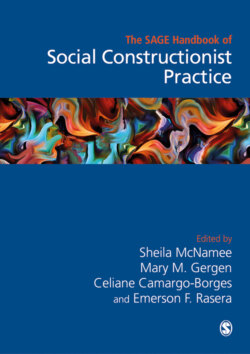Читать книгу The Sage Handbook of Social Constructionist Practice - Группа авторов - Страница 124
На сайте Литреса книга снята с продажи.
De-Centring Human in Social Construction
ОглавлениеHow we expand social construction from a primary focus on inter-human discursive practice to include other forms of materiality requires a new world-in-view of transmaterial discursive practice. This includes a review of what it means to be human as well as what/who is included in any study of discursive practice.
In her writings on the posthuman, Braidotti critiques how the concept of human has had its own binary logic (2013). The human hero, Anthropos, typicallymale-white-western-heterosexual-heteronormative-blond-tall-strong-alive-sexuallyactive-reproductive-young and so on, considers himself the highest entity on the worldly pyramid with a right to be owner-controller-namer of all other matter both within and beyond his reach (Braidotti, 2013). All other life forms are considered by Anthropos as inferior to him, passive, possessable, in need of control and therefore ‘othered’. This narrative of superior self and inferior other perpetuates not only social inequality but negates and neglects the needs of other material elements of the planet. Naming, Mary Gergen reminds us, is always a political act (Gergen, 2001). As researchers, we need to pay particular attention to the onto-epistemology of how our stories of ‘self’ and ‘other’ influence narratives of being in the world, of worlding (Barad, 2007).
What it means to be human has been changing. Humans are now techno-humans. To say we ‘have’ a phone perpetuates a distinction of separation, and ownership, between the human and the technological device. When we say, ‘My phone reminded me that …’ or ‘I messaged …’ these phrases still show phone and self as separate from each other and yet we have become fused with our gadgets (Haraway, 2004, 2015). Technology plays an increasingly significant role in how we interact in and with the world, how we communicate with others, in how our gadgets extend our memory, how we are remembered or lost by others, how we are identified by others, how we identify ourselves to our gadgets and remote systems, how we locate ourselves in the virtual-physical worlds, and how we are located by remote unknown others with or without our permission (Simon, 2010; Allinson, 2014).
Bateson (1972) posed the question of where the point of separation is between the blind man, his cane, and the environment he moves about in. Bronwyn Preece enquires into the intersections between ecology and disability, asserting from a first person account, that, ‘I engage with the other-than-human world as alive … I do not segregate biota from abiota, organic from non-organic, the trees from the forest, the ocean from the machines, the stone from mountain’ (Preece, 2019: 76). Braidotti (2013) asked if prosthetic limbs are really ‘otherwise human’. These questions invite us to consider if the phone can be seen as simply an implement (not us) to navigate the modern world (out there)? Or are humans enabling the phones to go about the business of remote corporations while the dominant narrative is of the phone enabling its owner? The mobile phone may not yet be a microchip under the physical skin of a human, but the proximity of humans and their devices is becoming increasingly intimate. Braidotti suggests that the relationship between human and technology has been extended to ‘unprecedented degrees of intimacy and intrusion’ (Braidotti, 2013: 89).
When we say we are inter-acting with someone or something, we are separating out parts of a relationship. The concept of ‘inter’ assumes ontological distinguishability between entities: things or people, apparently separate from ‘one another’, as configuring of ‘each other’, as doing things with ‘each other’. Gregory Bateson (1972) challenged the discursive practice of categorising, and therefore separating, subjects and things in a world which has the impact of obscuring relationality, highlighting differences over similarities and foregrounding thingness over relational activity. This separation of human and non-human can be understood as an epistemological error (Bateson, 1972). Nora Bateson asserts that transcontextual research is required to avoid these false separations. (Bateson, 2016). New materialist thinkers critique the anthropocentric narrative of human as separate from the world around them. According to Braidotti (2013) the posthuman subject is a ‘transversal entity, fully immersed in and immanent to a network of non-human … relations’ (Braidotti, 2013: 193). Karen Barad proposes that matter of all kinds is not separate but inevitably entangled. She says, ‘The very nature of materiality is an entanglement. Matter itself is always already open to, or rather entangled with, the “Other.” The intra-actively emergent “parts” of phenomena are co-constituted’ (Barad, 2007: 393). Barad explains that ‘humans enter not as fully formed, pre-existing subjects but as subjects intra-actively co-constituted through the material-discursive practices that they engage in’ (Barad, 2007: 168).
